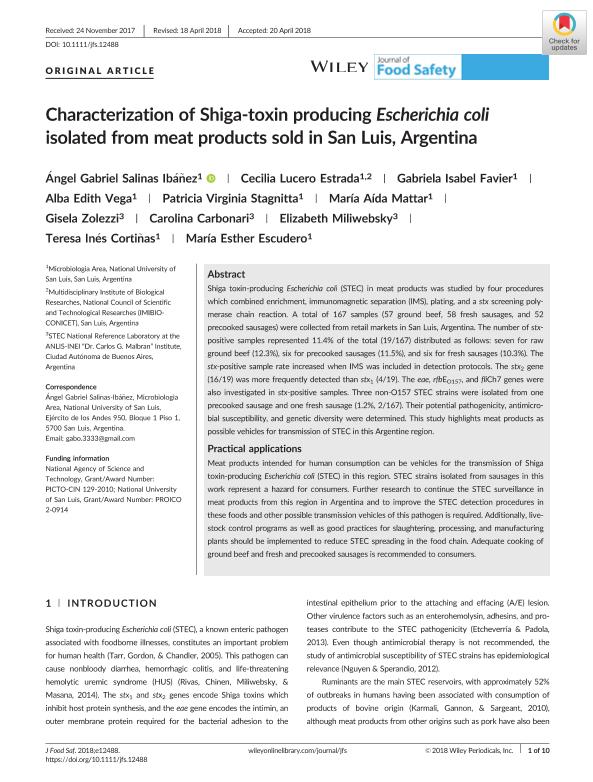Artículo
Characterization of Shiga-toxin producing Escherichia coli isolated from meat products sold in San Luis, Argentina
Salinas Ibañez, Angel Gabriel; Lucero Estrada, Cecilia Stella Marys ; Favier, Gabriela Isabel
; Favier, Gabriela Isabel ; Vega, Alba Edith; Stagnitta, Patricia Virginia; Mattar Domínguez, María Aída; Zolezzi, Gisela; Carbonari, Claudia Carolina; Miliwebsky, Elizabeth; Cortiñas, Teresa Inés; Escudero, María Esther
; Vega, Alba Edith; Stagnitta, Patricia Virginia; Mattar Domínguez, María Aída; Zolezzi, Gisela; Carbonari, Claudia Carolina; Miliwebsky, Elizabeth; Cortiñas, Teresa Inés; Escudero, María Esther
 ; Favier, Gabriela Isabel
; Favier, Gabriela Isabel ; Vega, Alba Edith; Stagnitta, Patricia Virginia; Mattar Domínguez, María Aída; Zolezzi, Gisela; Carbonari, Claudia Carolina; Miliwebsky, Elizabeth; Cortiñas, Teresa Inés; Escudero, María Esther
; Vega, Alba Edith; Stagnitta, Patricia Virginia; Mattar Domínguez, María Aída; Zolezzi, Gisela; Carbonari, Claudia Carolina; Miliwebsky, Elizabeth; Cortiñas, Teresa Inés; Escudero, María Esther
Fecha de publicación:
10/2018
Editorial:
Wiley Blackwell Publishing, Inc
Revista:
Journal of Food Safety
ISSN:
0149-6085
Idioma:
Inglés
Tipo de recurso:
Artículo publicado
Clasificación temática:
Resumen
Shiga toxin-producing Escherichia coli (STEC) in meat products was studied by four procedures which combined enrichment, immunomagnetic separation (IMS), plating, and a stx screening polymerase chain reaction. A total of 167 samples (57 ground beef, 58 fresh sausages, and 52 precooked sausages) were collected from retail markets in San Luis, Argentina. The number of stx-positive samples represented 11.4% of the total (19/167) distributed as follows: seven for raw ground beef (12.3%), six for precooked sausages (11.5%), and six for fresh sausages (10.3%). The stx-positive sample rate increased when IMS was included in detection protocols. The stx2 gene (16/19) was more frequently detected than stx1 (4/19). The eae, rfbEO157, and fliCh7 genes were also investigated in stx-positive samples. Three non-O157 STEC strains were isolated from one precooked sausage and one fresh sausage (1.2%, 2/167). Their potential pathogenicity, antimicrobial susceptibility, and genetic diversity were determined. This study highlights meat products as possible vehicles for transmission of STEC in this Argentine region. Practical applications: Meat products intended for human consumption can be vehicles for the transmission of Shiga toxin-producing Escherichia coli (STEC) in this region. STEC strains isolated from sausages in this work represent a hazard for consumers. Further research to continue the STEC surveillance in meat products from this region in Argentina and to improve the STEC detection procedures in these foods and other possible transmission vehicles of this pathogen is required. Additionally, livestock control programs as well as good practices for slaughtering, processing, and manufacturing plants should be implemented to reduce STEC spreading in the food chain. Adequate cooking of ground beef and fresh and precooked sausages is recommended to consumers.
Palabras clave:
CHARACTERIZATION
,
STEC
,
MEAT PRODUCTS
Archivos asociados
Licencia
Identificadores
Colecciones
Articulos(IMIBIO-SL)
Articulos de INST. MULTIDICIPLINARIO DE INV. BIO. DE SAN LUIS
Articulos de INST. MULTIDICIPLINARIO DE INV. BIO. DE SAN LUIS
Citación
Salinas Ibañez, Angel Gabriel; Lucero Estrada, Cecilia Stella Marys; Favier, Gabriela Isabel; Vega, Alba Edith; Stagnitta, Patricia Virginia; et al.; Characterization of Shiga-toxin producing Escherichia coli isolated from meat products sold in San Luis, Argentina; Wiley Blackwell Publishing, Inc; Journal of Food Safety; 38; 5; 10-2018; 1-10
Compartir
Altmétricas



